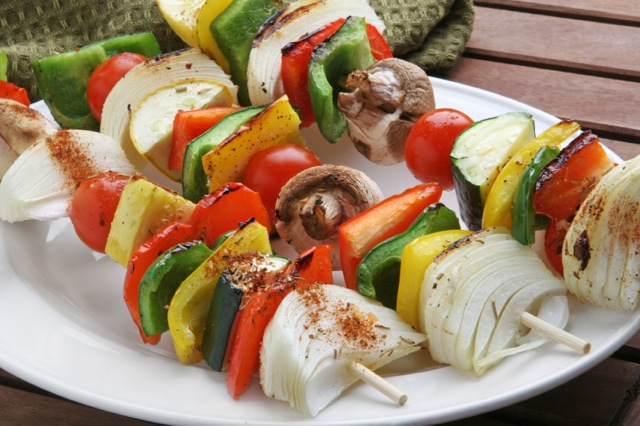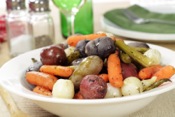When it comes to eating fruits and vegetables, we’re reminded to eat at least 5 a day. But for many of us, eating ve or more servings each day can seem a bit daunting.
Considering that we, on average, eat 3 meals a day, with 2-3 snacking occasions thrown into the mix, it turns out that there are plenty of opportunities to get our share of fruits and veggies. The following are suggestions that may help you enjoy your 5-a-day!
1. Buy in-season produce whenever possible at your local grocer or farmers market. In the summer months, it’s so delicious and refreshing to eat a variety of berries, stone fruits and melons, and hydrating veggies such as cucumbers, tomatoes and celery.
In cooler months, explore a variety of root vegetables, such as parsnips, sweet potatoes and onions. (To prolong their life, store them in a cool, dry place). And of course, fall brings a multitude of apple varieties to enjoy raw, baked or cooked.
2. Experiment with cooking methods. Fruits and vegetables take well to stir-frying, grilling, sautéing and roasting, and each technique brings out the flavors
and textures in foods in delectably-different ways.
3. Round out your servings with frozen or canned varieties of your favorite fruits and vegetables. These options are economical and convenient, but be sure that you select packages that are low in sodium and sugar. Keep fruit on hand for baking, and vegetables for soups and stews, or add them to egg dishes (for breakfast, lunch or dinner). Frozen or canned vegetables can be cooked in minutes in the microwave, making a quick and easy side dish.
4. Dont forget the herbs. Dried thyme, oregano, and red pepper flakes, for example, can add depth of flavor and texture to any savory dish. Fresh herbs like cilantro, basil or mint are perfect complements to both fruit and vegetable dishes.
Fruits in summer and fall:
5. Take it up a notch and try mixing fruit and veggies together. Saladsa summer and early fall favorite are perfect to experiment with; for example, add sliced stone fruit, or apples to a bed of mixed greens or baby spinach. Dress lightly with extra virgin olive oil and balsamic vinegar; season with black pepper, and top with cubes of your favorite goat cheese or feta.
6. Grill peaches, plums or other stone fruit. Select firm fruit, cut in half, remove pit, and baste each half with vegetable oil. Place on grill, and remove when grill marks appear and fruit becomes soft but not falling apart, approximately 4-5 minutes. Slice fruit into bite-size pieces and add to your favorite salad, or serve as a refreshing side to your favorite grilled meat or fish dish.
7. Enjoy fruit as dessert. Serve a mixture of berries, or grilled stone fruits (mentioned above), with a dollop of plain Greek yogurt. For a boost of flavor, stir vanilla or honey into the yogurt and serve with berries. Top with a few mint leaves for fragrance and embellishment.
Veggies in fall and winter:
8. Enjoy a medley of roasted vegetables. Carrots, parsnips, onions, and Brussels sprouts, are perfect for this type of cooking. Chop the veggies into
similar-sized chunks (so they’ll cook evenly) and toss with enough olive oil and a sprinkling of salt and dried herbs, such as thyme or oregano so each piece is coated with the mixture. Spread out on a rimmed cookie sheet or roasting pan, trying not to overcrowd or overlap the vegetables. In a preheated, 425° oven, roast the vegetables for 15-30 minutes, being sure to check frequently to ensure your veggies are cooking evenly. Vegetables are done when they’re tender, golden and carmelized.
9. Chop up a variety of veggies, such as peppers, onions, carrots, and mushrooms.
Heat up a sauté pan with a tablespoon of olive oil and sauté veggies one at a time, starting with the onion and then adding longer-cooking veggies like carrots, followed by the others. Season with dried herbs and cracked pepper at each addition. When veggies are soft, carmelized and oozing with flavor, add them to whole grain rice or pasta. If needed, add a little extra virgin olive oil and sprinkle with a fresh chopped herb such as parsley, and if desired, a grated hard cheese like Parmesan or Percorino Romano.
These sautéed vegetables can also be enjoyed as a side dish with your favorite fish or lean meat. Or add them to broth (let simmer in the broth for 20-30 minutes) for a quick and hearty vegetable soup. (Fresh, frozen or canned vegetables can be added to the broth, too).
11. Think mashed or pureed. Many root veggies take well to being mashed and pureed, especially parsnips, cauliflower, or sweet potatoes, as well as the perennial favorite, potatoes. Pureed veggies are delicious on their own, or they can be used to thicken soups, stews, and casseroles.
Snacks:
12. Keep ready-to-eat snacks on hand. Make a fruit salad and keep in a container in the fridge. Be sure to keep Greek yogurt on hand, too, for a creamy partner to the fruit salad.
13. Cut up vegetables such as carrots, celery, and peppers and place in small containers or bags; enjoy them at lunch or as a snack at your desk (or while you’re snacking in front of the TV).
14. Keep a bowl filled with apples, oranges, bananas, grapes in the fall/winter, and stone fruits in the warmer months, for a quick grab-&-go snack at home or on the run.
15. Roast kale, spinach or beet greens for a better-tasting-than-you-can-imagine snack. Check out this resource from our July Snacking kit and see how easy it is to make your own veggie chips.
There are a myriad of ways to enjoy fruits and vegetables any time of the day, any time of the year! For more ideas and information be sure to check out our Oldways Nutrition Exchange August 15 toolkit which is filled with tips on selecting and storing produce, recipes for enjoying the bounty in your basket once you get it home from the market, as all well as research related to eating more plant-based foods.
-Deborah










Leave a comment